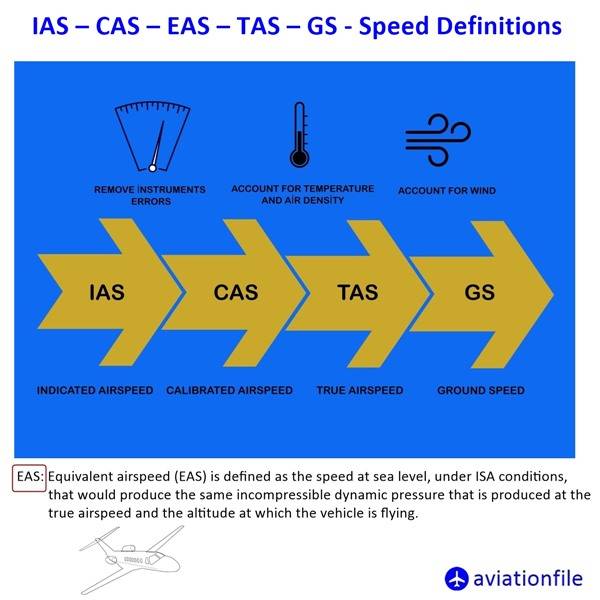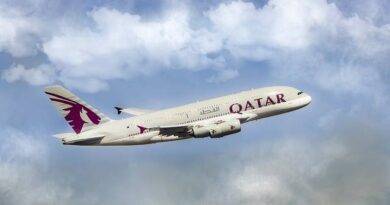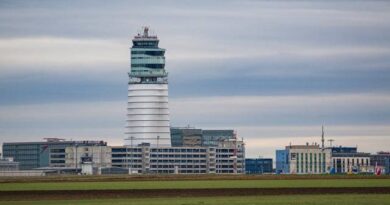IAS – CAS – EAS – TAS – GS – Speed Definitions
The “Pitot Static” system measures the Speed of airplanes. This system shows the velocity by making use of the difference between the pressure exerted by the airflow caused by the velocity on the hole at the Pitot end of a pipe called “Pitot Tube” and the static (static air) pressure on the side surfaces of the same tube or around the plane. There are some types of speeds used in airplanes. Let’s examine them (IAS-CAS-TAS-EAS-GS).
IAS (indicated airspeed)
IAS is the airspeed shown on the flight-deck instrument. The airspeed indicator measures the dynamic pressure of the outside air entering a pitot tube. At sea level, with an atmospheric pressure of 1013.2 mb, and no wind effect, the indicated airspeed is the true speed of the aircraft relative to the surface. As the aircraft climbs, the air density decreases, and the indicated speed will be less than the true airspeed (TAS). However, when it comes to controlling the aircraft, because the flight characteristics of the aircraft also alter with a reduction in atmospheric density, the indicated airspeed is of greater importance than the true airspeed.
CAS (Calibrated Airspeed)
Calibrated Airspeed is indicated airspeed corrected for instrument errors and position error due to incorrect pressure at the static port caused by airflow disruption.
- CAS is calculated as one of the steps between indicated airspeed (IAS) and true airspeed (TAS).
- CAS is one of the primary reference points for aircraft control, as it describes the dynamic pressure acting on aircraft surfaces regardless of the existing conditions of temperature, pressure, altitude, or wind.
TAS (true airspeed)
TAS is the speed of the aircraft relative to the air mass in which it is flying. As an aircraft climbs, its true airspeed is higher than its indicated airspeed. Pressure decreases at higher altitudes. Therefore, for any given true airspeed, as you climb, fewer and fewer air molecules will enter the pitot tube. Because of that, indicated airspeed will be less than true airspeed. In fact, for every thousand feet above sea level, true airspeed is about 2% higher than indicated airspeed. So at 10,000 feet, true airspeed is roughly 20% faster than what you read off your airspeed indicator.
Equivalent airspeed (EAS)
EAS is the airspeed at sea level in the International Standard Atmosphere at which the dynamic pressure is the same as the dynamic pressure at the true airspeed (TAS) and altitude at which the aircraft is flying. At standard sea-level pressure, calibrated airspeed and equivalent airspeed are equal. Up to about 200 knots CAS and 10,000 feet, the difference is negligible, but at higher speeds and altitudes, CAS must be corrected for compressibility error to determine the EAS.
Ground Speed (GS)
Ground speed is the speed of an aircraft relative to the surface of the earth (ICAO Doc 9426).
Groundspeed is the vector sum of true airspeed (TAS) and wind velocity. In other words, GS is true airspeed corrected for wind. With a true airspeed of 300 knots and a direct tailwind of 50 knots, you’d be flying at a ground speed of 350 knots.
How to Use These Speed Measurements
Pilots use these speed measurements to make a variety of decisions, such as when to take off and land, how to avoid other aircraft and obstacles, and how to fly efficiently.

Here are some examples of how these speed measurements are used:
- When taking off, pilots need to make sure that they have enough airspeed to get airborne. They use IAS to determine this.
- When landing, pilots need to make sure that they are not going too fast, or they will overshoot the runway. They use CAS to determine this.
- When avoiding other aircraft and obstacles, pilots need to make sure that they are not too close. They use TAS to determine this.
- When flying efficiently, pilots need to make sure that they are not flying too fast or too slow. They use GS to determine this.
Conclusion
Understanding IAS, CAS, TAS, EAS, and GS is essential for pilots to fly safely and efficiently.
References:
- Wikipedia: https://en.wikipedia.org/wiki/Airspeed
- The Airplane Flying Handbook: https://www.govinfo.gov/content/pkg/CFR-2010-title14-vol1/pdf/CFR-2010-title14-vol1-sec23-1323.pdf
- Pilot Training Manual: https://www.faa.gov/regulations_policies/handbooks_manuals/aviation
- Glossary of Aviation Terms: https://www.faa.gov/air_traffic/publications/media/pcg_10-12-17.pdf
- NASA: https://www.nasa.gov/aeronautics/
For more articles click.


